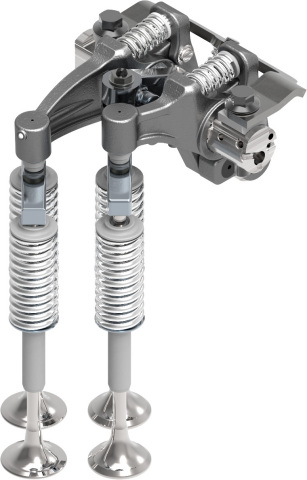
Power management company Eaton announced it has expanded its innovative portfolio of valvetrain solutions for diesel off-highway vehicles to help OEMs reduce emissions and improve fuel economy.
Eaton’s new technology allows for cost-effective, variable valve actuation with hydraulic lash adjustment (HLA) function. This technology enables precise valve lift control through HLA, coupled with engine braking capability, which in turn helps reduce emissions and improve fuel economy.
“Up until now, nitrogen oxide (NOx) emissions regulations have targeted on-road vehicles, and those regulations have been successful in reducing NOx in high-speed highway applications,” said Dr. Mihai Dorobantu, director, Technology Planning and Government Affairs, Eaton’s Vehicle Group. “The same technologies that reduce emissions and increase fuel economy in on-highway, low-load duty cycles are applicable to off-highway equipment—so we expect the off-highway segment to face similar pressure to reduce NOx very soon.”
n the commercial vehicle segment, U.S. regulations mandate manufacturers reduce carbon dioxide (CO2) by up to 20 percent by 2024 and up to 27 percent by 2027. The California Air Resources Board (CARB) is expected to mandate reductions of NOx emissions by approximately 70 percent by 2024 and up to 90 percent by 2027. Additionally, the Environmental Protection Agency (EPA) and CARB are both evaluating new low-load cycle and in-use requirements. Similar mandated reductions in emission levels are expected in European regulations.
Eaton’s cylinder-deactivation (CDA) technology increases the exhaust temperature at low load to allow NOx aftertreatment systems to quickly reach peak efficiency range of 250°C –400°C. While other technologies can be combined to reduce both CO2 and NOx emissions, Eaton’s CDA stands out as one of the only technologies that can simultaneously reduce both.
Dorobantu said Eaton sees strong opportunities in the commercial vehicle diesel market with products that help reduce CO2 and NOx, including CDA technology, exhaust gas recirculation (EGR) pumps and efficient transmission technologies.
CDA is just one of Eaton’s variable valve actuation (VVA) technologies. Other technologies include late intake valve closing (LIVC) and early exhaust valve opening (EEVO), which modify valve operation to allow engine manufacturers various methods to maximize aftertreatment efficiency and minimize fuel consumption. In addition to keeping the aftertreatment system warm, LIVC also enables high compression ratios for diesel engines and fast SCR heating at engine start-up.
Eaton’s Twin Vortices Series (TVS®) EGR pump, which enables the replacement of a variable geometry turbo (VGT) plus EGR valve architecture with a more efficient fixed geometry turbo (FGT), improves engine efficiency and reduces CO2.
“Having a suite of VVA technologies allows OEMs to combine different valvetrain control functions to best optimize both fuel economy and aftertreatment efficiency,” said Karl Sievertsen, vice president, Engineering, and chief technical officer, Eaton’s Vehicle Group.
Eaton VVA solutions are flexible and adaptable to any valvetrain architecture, allowing OEM customers to implement multiple functions such as CDA and engine braking in tight packaging.
Eaton’s HLA technology optimizes valvetrain performance by providing precise valve timing over the life of the vehicle. Other benefits include noise reduction and service elimination for manual valvetrain lash settings.
Eaton’s mission is to improve the quality of life and the environment through the use of power management technologies and services. We provide sustainable solutions that help our customers effectively manage electrical, hydraulic, and mechanical power – more safely, more efficiently, and more reliably. Eaton’s 2019 revenues were $21.4 billion, and we sell products to customers in more than 175 countries. We have approximately 97,000 employees. For more information, visit www.eaton.com












More Stories
Professional vs. DIY Tinting: What You Should Know
New updated edition of “PXIMate” reference guide for T&M engineers available from Pickering Interfaces
5 Mistakes That Can Ruin Your Car Accident Claim